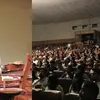From Monet to the Moon: how creativity spans diverse genres, themes, and forms
In this photo essay, we show how a major art museum curates collections that dig into artists’ diverse styles, showcases historical trends, and sheds light on future developments.
Launched in 2014, PhotoSparks is a weekly feature from YourStory, with photographs that celebrate the spirit of creativity and innovation. In the earlier 375 posts, we featured an art festival, cartoon gallery. world music festival, telecom expo, millets fair, climate change expo, wildlife conference, startup festival, Diwali rangoli, and jazz festival.

Kunsthaus Zurich is one of Switzerland’s major art museums, and a new extension opening in 2021 is set to make it the country’s largest art museum, overtaking Basel. With its location between Italy, France, and Germany, Switzerland is well positioned as a regional arts hub. In this photo essay, we feature more of the artworks on display (see Part I and Part II of our coverage as well).
The lineup of artists, some of whom are featured here, includes Frantz Gertsch, Fernand Leger, Rudoph Koller, Albert Anker, Adriaen Coorte, Giovanni Paolo Panini, Bernardo Bellotto, and Urs Fischer. The curated exhibitions dig deep into trends and developments shaping art and society.
For example, during the recent 50th anniversary of the Moon landing, there was an exhibition on how artists respond to this momentous event, with 200 works from the Romantic era to the present day. They addressed themes like not just topography but even ailments associated with the Moon, and the Moon as mass media phenomenon.
Planet Earth looks small and vulnerable from outer space, in stark contrast to the opportunistic egos of its inhabitants, curator Cathérine Hug jokes. A catalogue was also published, with essays on the Moon and its ‘conquest’ from the perspectives of cultural studies, technology, ethnology, and art.
Panels were held on emerging topics like space law, with Kai-Uwe Schrogl, Head of the Strategy Department at the European Space Agency and Guido Schwarz, Founder of the Swiss Space Museum.
Kunsthaus has also cultivated an exceptional collection of French and Norwegian artworks as well. A research department ensures that the collections of paintings and sculptures can be scientifically appraised and the results published. For example, care has been taken to ensure that works which entered the collection between 1933 and 1950 were not looted art.
The Kunsthaus has a long tradition of setting up dialogues between drawing and painting, and between older and more modern art, explains curator Jonas Beyer. For example, its art collection of the master Henri Matisse includes lesser-known bronze sculptures. His paintings and drawings parallel his sculptures.
Sources of inspiration such as photographs are also included, as well as photographs showing the artist at work. There are similar collections of works on paper of other artists like Picasso, Gorky and Warhol, exploring the connections between drawings and sculptures.
Kunsthaus also has a foot in the digital era: it has digitised its collection of over 400 original pieces of Dada works, the art movement rooted in Zurich and which paved the way for the surrealists. The digital archives span paper, photographs, letters, books, magazines, flyers, and manuscripts.
They represent the works of Marcel Duchamp, Man Ray, Hans Arp, Tristan Tzara, Hugo Ball, André Breton, and others. Other exhibitions on The New Photography explore the commercial and artistic movements in the 1970s and 80s.
Now, what have you done today to pause in your busy schedule and see how you can bridge past and future trends?






















Got a creative photograph to share? Email us at [email protected]!
See also the YourStory pocketbook ‘Proverbs and Quotes for Entrepreneurs: A World of Inspiration for Startups,’ accessible as apps for Apple and Android devices.








